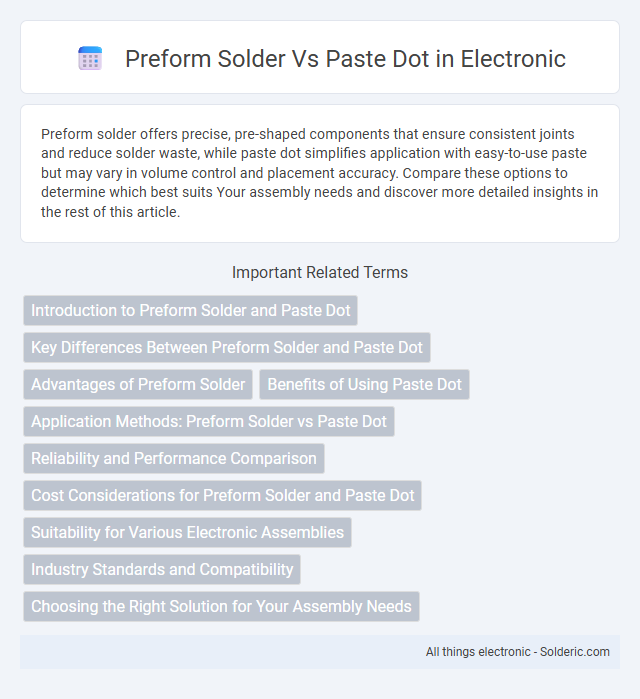Preform solder offers precise, pre-shaped components that ensure consistent joints and reduce solder waste, while paste dot simplifies application with easy-to-use paste but may vary in volume control and placement accuracy. Compare these options to determine which best suits Your assembly needs and discover more detailed insights in the rest of this article.
Comparison Table
| Feature | Preform Solder | Paste Dot |
|---|---|---|
| Form | Pre-shaped solid pieces | Printed or dispensed solder paste droplets |
| Application | Precise placement on pads or joints | Surface mount components and reflow soldering |
| Consistency | Exact volume, consistent weight | Variable volume, requires stencil control |
| Cleanliness | Minimal residue, less flux needed | May leave flux residues |
| Storage | Long shelf life, stable at room temperature | Shorter shelf life, refrigeration recommended |
| Process Control | Highly repeatable and controlled | Requires precise stencil printing and paste handling |
| Typical Uses | High-reliability electronics, power devices | General PCB assembly, mass production |
| Cost | Higher unit cost, less material waste | Lower unit cost, potential paste waste |
Introduction to Preform Solder and Paste Dot
Preform solder is a precisely shaped alloy piece designed for consistent and controlled soldering applications, ensuring uniform joint quality and reduced solder waste. Paste dots, composed of solder powder suspended in flux, offer flexibility for a wide range of PCB assembly processes by enabling precise solder placement and reflow compatibility. Both techniques serve distinct roles in electronics manufacturing, with preforms excelling in repeatability and paste dots providing adaptability for intricate circuit designs.
Key Differences Between Preform Solder and Paste Dot
Preform solder offers precise, pre-shaped metal pieces designed for consistent volume and placement in soldering applications, while paste dot is a semi-solid, stencil-applied fluxed solder paste that requires reflow to form joints. Preforms provide improved control over joint size and reduce solder waste, making them ideal for complex or high-reliability assemblies, whereas paste dots are simpler for high-volume, surface-mount processes. Your choice depends on factors like component geometry, process control, and production volume requirements.
Advantages of Preform Solder
Preform solder offers precise alloy composition and consistent volume control, resulting in reliable and repeatable solder joints essential for high-quality electronic assemblies. Its solid, pre-shaped form minimizes solder wastage and improves placement accuracy compared to paste dots, enhancing manufacturing efficiency and reducing defects. Furthermore, preform solder eliminates issues related to paste storage and mixing, ensuring superior shelf-life stability and uniformity in thermal profile during reflow soldering processes.
Benefits of Using Paste Dot
Paste dot offers precise control over the amount and placement of solder, reducing waste and improving consistency in solder joints. Its ease of application speeds up the manufacturing process while minimizing defects such as bridging and tombstoning. Your production can achieve higher reliability and lower rework costs by using paste dot compared to preform solder.
Application Methods: Preform Solder vs Paste Dot
Preform solder is applied using precise placement techniques such as pick-and-place machines, ensuring consistent shape and volume for reliable solder joints, especially in high-reliability electronics. Paste dots, consisting of solder powder suspended in flux, are typically dispensed or screen-printed onto pads, offering flexibility but with variable volume and shape control. Your choice between preform solder and paste dot depends on the required precision, reflow profile, and the specific manufacturing process constraints.
Reliability and Performance Comparison
Preform solder offers superior reliability due to its consistent volume and shape, ensuring uniform joint strength and reducing the risk of voids and defects compared to paste dots. Paste dots can vary in application accuracy and solder volume, potentially leading to inconsistent wetting and mechanical performance under thermal cycling. Your assembly's long-term performance benefits from preform solder's precise metallurgical composition and controlled placement, enhancing joint integrity in high-reliability electronics.
Cost Considerations for Preform Solder and Paste Dot
Preform solder typically incurs higher initial costs due to precise manufacturing and material consistency, but it reduces waste and rework expenses in complex assemblies. Paste dot solder offers lower upfront costs and ease of application, yet can lead to increased variability and potential defects impacting long-term reliability. Evaluating production volume and application complexity is essential for optimizing overall cost efficiency between preform solder and paste dot solutions.
Suitability for Various Electronic Assemblies
Preform solder offers precise control over solder volume, making it ideal for complex assemblies requiring consistent joint quality, such as fine-pitch components and high-reliability aerospace electronics. Paste solder dots are better suited for high-volume manufacturing where rapid application and reflow processes are essential, commonly used in consumer electronics and PCBs with larger pads. Both materials enhance solder joint integrity, but preform solder excels in applications demanding uniformity, while paste solder provides efficiency in mass production.
Industry Standards and Compatibility
Preform solder and paste dot each adhere to industry standards such as IPC J-STD-001 for soldering materials, ensuring reliable electrical connections in electronics manufacturing. Preform solder offers precise, premeasured quantities compatible with automated placement systems, enhancing repeatability and reducing waste compared to solder paste dots. Your choice between these materials should consider compatibility with PCB surface finishes and reflow profiles to maintain assembly quality and process consistency.
Choosing the Right Solution for Your Assembly Needs
Preform solder offers precise volume control and is ideal for high-volume, automated assembly processes requiring consistent joint quality, while paste solder provides flexibility and ease of use for prototyping or low-volume production. Selecting the right solder solution depends on factors such as thermal profiles, component sizes, and paste shelf life, with preform solder minimizing waste and improving repeatability in complex assemblies. Evaluating these criteria ensures optimal reliability and efficiency tailored to specific manufacturing requirements.
Preform solder vs paste dot Infographic

 solderic.com
solderic.com